Abstract
This research provides a model for the operationalization of psychological training for an athlete in athletics jumping events, obtained by means of a case study realized within a 3-year experiment. Optimization of an athlete’s level of motivation through the operationalization of the psychological training aims at maximizing the level of performance achieved by the athlete. The research was carried out using specific techniques, based on quantifying motivational levels in order to identify global motivational force (GMF), determining the general motivation instrumentality (GMI) and the motivation instrumentality (MI) by motivational factors, which reflect the independent variables of motivation, these generating objectives in the optimization of psychological training. Quantifying the motivational level of an athlete revealed to us the sensitive differences between the values of the athlete (7.35) and those of his coach (6.85), in his perception of the athlete’s motivational structures. Based on the values identified regarding the general motivation instrumentality (GMI) for the athlete O.M. and taking into consideration the evaluation of the athlete by his coach and the ranking of each motivational factor, we were able to create objectives for psychological training. The results recorded throughout the research show an ascending curve in the GMF values of the athlete, from 7.35 to 8.57, values which signify a motivational profile with increased tendencies towards a higher level. Applying this strategy with regards to optimizing the motivational level of the athlete (O.M.) through operationalizing his psychological training leads to an improvement in both GMI and GMF values.
Keywords: Athletes; motivation, jumping events
1. Introduction
In competitive sport, motivation can have a positive or negative effect on the behaviour of the
athlete, depending greatly on the way the entire process of organizing and running the sports training is
carried out. Motivation is the factor which activates, coordinates and guides all of the actions and
reactions of the athlete. In order to reach competition objectives and adapt efficiently to the specific
requirements, the jumping event athlete must be motivated so that they can put in the necessary effort
to achieve high performance. Motivation is one of the determining factors of sports performance, thus
being considered a generator of sports performance. Sports performance can be influenced by the
intensity of the athlete’s motivation. Human performance, including that of sport, can be explained as a
multiplicative factor of motivation and possibilities/aptitudes (Epuran, Holdevici, & Tonița, 2008;
Duda et al., 1995; Mamali, 1981), P = f (MxA) (Bologa & Gherghișan 1994). Before moving on to the
implementation of mechanisms designed to motivate the potential of the competitive athlete, it is
essential to identify the factors which influence the sources of individual motivation and use them as
such in order to obtain positive, efficient reactions in the attitudinal system and behaviour of the
individual.
We believe that understanding the motivational structure, as well as the influences received from the
athlete’s system of values, is the key in determining the conditions through which the level of
motivation can be optimized in order for the athlete to achieve high performance in competition.
Under the assumption that motivation is “a state which energizes behaviour and offers it a direction”
(Atkinson & Hilgard, 2005, quoted by Mihăilescu & Haralambie, 2011) fulfilling a regulatory function
in the conduct of the athlete, and is determined by the consciously proposed purpose for their activity,
this research was initiated with the aim of optimizing the level of motivation of a jumping event athlete
for maximizing his sports performance.
With a view to optimizing the level of motivation in order to maximize sports performance, we
sought to achieve the following objectives: determine the level of motivation of the athlete and the
independent variables of global motivational force (GMF); determine the global motivational
instrumentality (GMI) and the instrumentation of motivation by motivational factors; create the
objectives of the athlete’s psychological training focused on increasing the global motivational force
(GMF) and personalize this training for the jumping event athlete, our case study; develop and
experiment an intervention strategy for the optimization of psychological training of the jumping event
athlete, for the purpose of maximizing performance in forthcoming competitions.
2. Methods
The experimental study was carried out using specific techniques, based on quantifying levels of
motivation which reflect the independent variables of motivation, therefore generating the objectives
necessary for the optimization of psychological training. In order to quantify motivation levels, we
used 14 motivational items reflecting both intrinsic and extrinsic forms of motivation (validated by
Bologa & Gherghișan, 1994; Haralambie & Mihăilescu, 2010; Haralambie, 2010), as can be seen in Table 1.
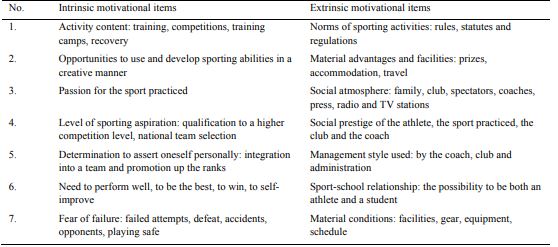
Social prestige of the athlete, the sport practiced, the club and the coach
Management style used: by the coach, club and administration
Sport-school relationship: the possibility to be both an athlete and a student
Material conditions: facilities, gear, equipment, schedule
Determining the values of the independent variables of motivation, both GMF and GMI, was
achieved by means of the survey method using a questionnaire. The items of the questionnaire were
focused on evaluating the valence (V), expectancy (E) and instrumentation (I) of motivation.
VxE = GMF; Vx I = GMI
The research is based on a case study, a unique experiment, owing to the fact that athletics as a sport
requires individual training. The questionnaires were completed by the athlete and his coach. This
crossover method was used so as to observe the perception of the coach regarding the athlete, in terms
of leverage and motivational resources in training, in order to increase the efficiency of the athlete’s
preparation for competition.
3. Results
Quantifying the athlete’s level of motivation revealed to us the subtle differences between the values
of the athlete and those of the coach, with regards to motivational structures. The GMF value of the
athlete (7.35) constituted a medium level of motivation, a fact also observed in the perception of the
coach, who recorded a lower value (6.85) than that of the athlete, falling, however, into the same level
on the motivational scale (Graph 1).
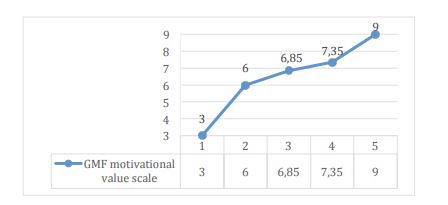
The values of V, E, I, GMI and the rank hierarchy of MI for the athlete O.M. were compared with
the standards determined by Haralambie and Mihăilescu (2010) for the athletes (seniors) in the
formative stage of training (Tables 2, 3).
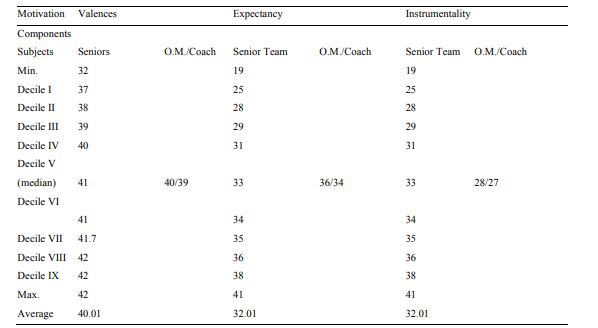
In order to optimize the level of motivation of the athlete by operationalizing his psychological
training, we identified the global motivational instrumentality and determined the values of motivation
instrumentation by motivational factors. The results of the research show a lower level in the case of
athlete O.M. when compared to the IM of the seniors (Table 3). The values recorded in the case of
seniors for the valence and instrumentality of motivational variables (Table 2) compared to the results
of athlete O.M. allowed us the opportunity to optimize the psychological training of the athlete. Based
on the values recorded for the athlete O.M. and taking into consideration the evaluation of the athlete
by his coach and the ranking of each motivational factor (Table 1), we were able to create
psychological training objectives aimed at increasing motivation indicators (Table 3).
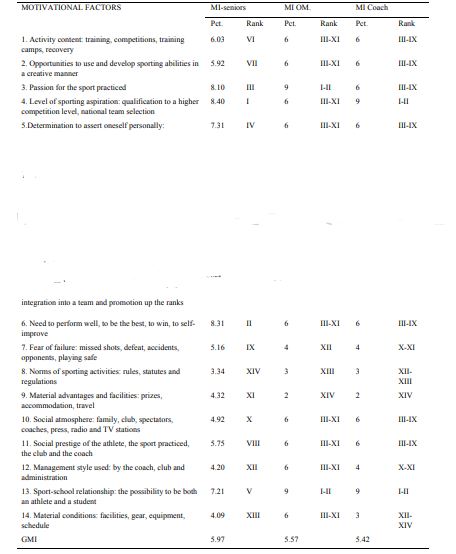
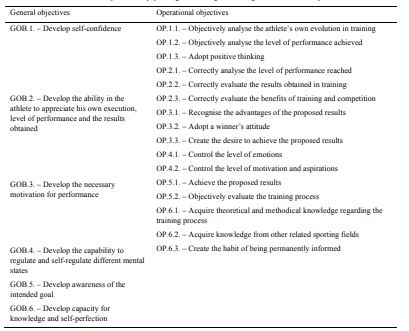
Based on the data obtained in the process of quantifying the level of motivation of the athlete O.M.
and in correlation with the objectives aimed, an action plan was drawn up to optimize the athlete’s
motivation level. The action plan was materialized through operational strategies designed to achieve
the optimal level of motivation for the forthcoming competition. Following the implementation of this
strategy, we noticed an improvement in the GMI values both in the evaluation of the athlete and that of the coach. Graph 2 shows the evolution of GMI values for the subject O.M. during the research. This progress is due to our efforts to improve the behaviour of the athlete regarding his attitude towards assuming responsibility and understanding that, by engaging in conscious and active activity, his level of performance can improve.
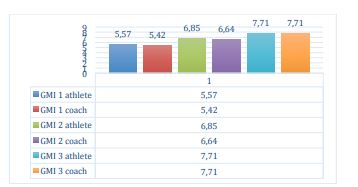
In the graph below, we can see that the process undertaken to improve the level of motivation of the athlete was successful. Over the course of the research, we observed a continual increase in the GMF values of the athlete, values which signify a motivational profile with great potential.
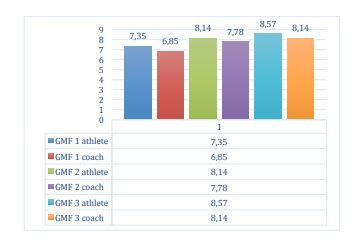
4. Conclusions
The results recorded throughout the research show an ascending curve in the GMF values of the
athlete, from 7.35 to 8.57, values which signify a motivational profile with great potential.
Applying this strategy with regards to optimizing the motivational level of the athlete O.M. by
operationalizing his psychological training will lead to an improvement in both GMI and motivation
instrumentality by motivational factors, this having a lower value than that of the seniors (Table 3). The
lower values of some of the external motivational factors recorded in the results of the athlete created
the opportunity to optimize the psychological training of the athlete by improving them, as well as by
developing internal motivational factors.
This approach has led to the optimization of the motivational level of the athlete, who recorded a
value of 8.57 at the end of the experiment. This ascending trend of motivation level was also identified
within the results obtained following an evaluation of the coach’s perception of the athlete’s level of
motivation.
References
Bologa, M., & Gherghișan, D. (1994). Posibilități de cuantificare a motivației în activitatea sportivă.
Simpozionul Științific Național “Pregătirea sportivilor de înaltă performanță” (pp. 119-125). București. [Conferința Consiliului Științei Sportului].
Duda, J. L., Li-Kang, C., Newton, M. Walling, M. D., … & Catley, D. (1995). Task and ego orientation and intrinsic motivation in sport. International Journal of Sport Psychology, 26(1), 40-63.
Epuran, M., Holdevici, I., & Tonița, F. (2008). Psihologia sportului de performanță – Teorie și practică. București:FEST.
Haralambie, A. (2010). Posibilităţi de optimizare a nivelului motivaţional al atleţilor de performanţă (Teză de doctorat). Universitatea din Pitești.
Haralambie, A., & Mihăilescu, L. (2010). Research concerning the motivation’s quantification for performance athletes. Citius Altius Fortius, Journal of Physical Education and Sport, 2(27), 79-85.
Mamali, C. (1981). Balanţă motivaţională şi coevoluţie. Bucureşti: Editura Ştiinţifică şi Enciclopedică. Mihăilescu, L., & Şerban, A. (2005). Experienţe privind cuantificarea motivaţiei în sportul de performanţă.Ştiinţa Sportului, 45, 14-18.
Mihăilescu, L., Haralambie, A., Mihăilescu, N., & Mihăilescu, L. (2011).Determining the motivations features formative stages athletics. Gymnasium - Journal of Physical Education and Sport, 12(1), 142-152.
Mihăilescu, L., Haralambie, A., Mihăilescu, L. E., & Mihăilescu, N. (2012). The quantification of the motivational level of the performance athletes. Procedia – Social and Behavioural Sciences, 84, 29-33.
Copyright information

This work is licensed under a Creative Commons Attribution-NonCommercial-NoDerivatives 4.0 International License.
About this article
Publication Date
10 June 2016
Article Doi
eBook ISBN
978-1-80296-010-5
Publisher
Future Academy
Volume
11
Print ISBN (optional)
-
Edition Number
1st Edition
Pages
1-509
Subjects
Sports, sport science, physical education
Cite this article as:
Ionela Cucui, A. (2016). Research Regarding Optimization of an Athlete’s Motivation Level in Athletics Jumping Events. In V. Grigore, M. Stanescu, & M. Paunescu (Eds.), Physical Education, Sport and Kinetotherapy - ICPESK 2015, vol 11. European Proceedings of Social and Behavioural Sciences (pp. 185-191). Future Academy. https://doi.org/10.15405/epsbs.2016.06.26

